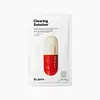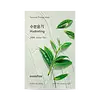What's inside
What's inside
 Key Ingredients
Key Ingredients

 Benefits
Benefits

 Concerns
Concerns

No concerns
 Ingredients Side-by-side
Ingredients Side-by-side

Glycerin
HumectantNiacinamide
SmoothingGlycereth-26
HumectantSodium Hyaluronate
HumectantCalcium Pantothenate
Sodium Ascorbyl Phosphate
AntioxidantTocopheryl Acetate
AntioxidantPyridoxine Hcl
Skin ConditioningMaltodextrin
AbsorbentSodium Starch Octenylsuccinate
AbsorbentSilica
AbrasiveTrehalose
HumectantHydroxyethyl Urea
HumectantBetaine
HumectantErythritol
HumectantGlutathione
PEG/PPG-17/6 Copolymer
SolventButylene Glycol
HumectantPEG-14m
Emulsion StabilisingAllantoin
Skin ConditioningXanthan Gum
EmulsifyingMelaleuca Alternifolia Leaf Oil
AntioxidantSalicylic Acid
MaskingDisodium EDTA
Carbomer
Emulsion StabilisingTriethanolamine
BufferingPEG-60 Hydrogenated Castor Oil
EmulsifyingEthylhexylglycerin
Skin ConditioningPhenoxyethanol
PreservativeGlycerin, Niacinamide, Glycereth-26, Sodium Hyaluronate, Calcium Pantothenate, Sodium Ascorbyl Phosphate, Tocopheryl Acetate, Pyridoxine Hcl, Maltodextrin, Sodium Starch Octenylsuccinate, Silica, Trehalose, Hydroxyethyl Urea, Betaine, Erythritol, Glutathione, PEG/PPG-17/6 Copolymer, Butylene Glycol, PEG-14m, Allantoin, Xanthan Gum, Melaleuca Alternifolia Leaf Oil, Salicylic Acid, Disodium EDTA, Carbomer, Triethanolamine, PEG-60 Hydrogenated Castor Oil, Ethylhexylglycerin, Phenoxyethanol
Water
Skin ConditioningButylene Glycol
HumectantDipropylene Glycol
HumectantGlycerin
HumectantGlyceryl Polymethacrylate
1,2-Hexanediol
Skin ConditioningPolyglyceryl-10 Laurate
Skin ConditioningArginine
MaskingCarbomer
Emulsion StabilisingGlyceryl Caprylate
EmollientXanthan Gum
EmulsifyingEthylhexylglycerin
Skin ConditioningCamellia Sinensis Leaf Extract
AntimicrobialPaeonia Suffruticosa Root Extract
Skin ProtectingCentella Asiatica Extract
CleansingDisodium EDTA
Chamomilla Recutita Flower Extract
MaskingRosa Damascena Flower Water
MaskingPyrus Communis Fruit Extract
Skin ConditioningCucumis Melo Seed Extract
Skin ConditioningDiethylhexyl Sodium Sulfosuccinate
CleansingIris Florentina Root Extract
MaskingSodium Hyaluronate
HumectantVetiveria Zizanoides Root Oil
MaskingWater, Butylene Glycol, Dipropylene Glycol, Glycerin, Glyceryl Polymethacrylate, 1,2-Hexanediol, Polyglyceryl-10 Laurate, Arginine, Carbomer, Glyceryl Caprylate, Xanthan Gum, Ethylhexylglycerin, Camellia Sinensis Leaf Extract, Paeonia Suffruticosa Root Extract, Centella Asiatica Extract, Disodium EDTA, Chamomilla Recutita Flower Extract, Rosa Damascena Flower Water, Pyrus Communis Fruit Extract, Cucumis Melo Seed Extract, Diethylhexyl Sodium Sulfosuccinate, Iris Florentina Root Extract, Sodium Hyaluronate, Vetiveria Zizanoides Root Oil
 Reviews
Reviews

Ingredients Explained
These ingredients are found in both products.
Ingredients higher up in an ingredient list are typically present in a larger amount.
Butylene Glycol (or BG) is used within cosmetic products for a few different reasons:
Overall, Butylene Glycol is a safe and well-rounded ingredient that works well with other ingredients.
Though this ingredient works well with most skin types, some people with sensitive skin may experience a reaction such as allergic rashes, closed comedones, or itchiness.
Learn more about Butylene GlycolCarbomer is a polymer of acrylic acid. Its main role is to create a gel consistency.
A high amount of carbomer can cause pilling or balling up of products. Don't worry, most products contain 1% or less of carbomer.
Disodium EDTA plays a role in making products more stable by aiding other preservatives.
It is a chelating agent, meaning it neutralizes metal ions that may be found in a product.
Disodium EDTA is a salt of edetic acid and is found to be safe in cosmetic ingredients.
Learn more about Disodium EDTAEthylhexylglycerin (we can't pronounce this either) is commonly used as a preservative and skin softener. It is derived from glyceryl.
You might see Ethylhexylglycerin often paired with other preservatives such as phenoxyethanol. Ethylhexylglycerin has been found to increase the effectiveness of these other preservatives.
Glycerin is already naturally found in your skin. It helps moisturize and protect your skin.
A study from 2016 found glycerin to be more effective as a humectant than AHAs and hyaluronic acid.
As a humectant, it helps the skin stay hydrated by pulling moisture to your skin. The low molecular weight of glycerin allows it to pull moisture into the deeper layers of your skin.
Hydrated skin improves your skin barrier; Your skin barrier helps protect against irritants and bacteria.
Glycerin has also been found to have antimicrobial and antiviral properties. Due to these properties, glycerin is often used in wound and burn treatments.
In cosmetics, glycerin is usually derived from plants such as soybean or palm. However, it can also be sourced from animals, such as tallow or animal fat.
This ingredient is organic, colorless, odorless, and non-toxic.
Glycerin is the name for this ingredient in American English. British English uses Glycerol/Glycerine.
Learn more about GlycerinSodium Hyaluronate is hyaluronic acid's salt form. It is commonly derived from the sodium salt of hyaluronic acid.
Like hyaluronic acid, it is great at holding water and acts as a humectant. This makes it a great skin hydrating ingredient.
Sodium Hyaluronate is naturally occurring in our bodies and is mostly found in eye fluid and joints.
These are some other common types of Hyaluronic Acid:
Learn more about Sodium HyaluronateXanthan gum is used as a stabilizer and thickener within cosmetic products. It helps give products a sticky, thick feeling - preventing them from being too runny.
On the technical side of things, xanthan gum is a polysaccharide - a combination consisting of multiple sugar molecules bonded together.
Xanthan gum is a pretty common and great ingredient. It is a natural, non-toxic, non-irritating ingredient that is also commonly used in food products.
Learn more about Xanthan Gum